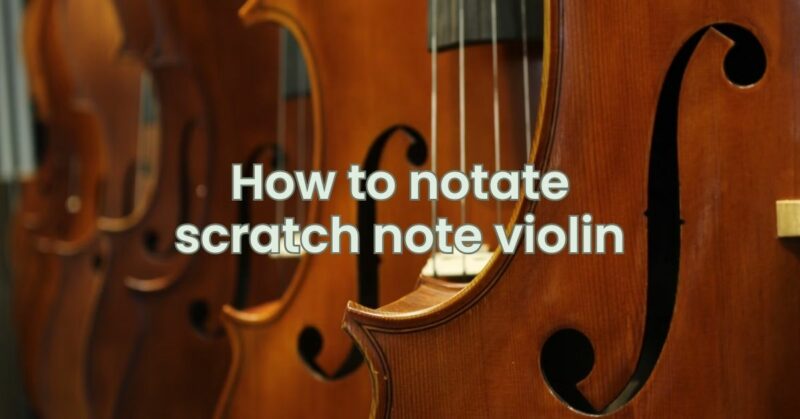Contemporary music often embraces unconventional techniques that push the boundaries of traditional instrumental playing. The scratch technique on the violin is one such innovation that adds unique textures and sounds to compositions. Notating scratch notes effectively is essential for communicating these distinct sounds to performers. In this article, we’ll explore how to accurately notate scratch notes for the violin, ensuring that your musical ideas are brought to life authentically.
Understanding Scratch Technique on the Violin
The scratch technique involves using the bow to produce a rough, raspy sound on the strings of the violin. This sound is distinct from regular bowing and creates a gritty, percussive effect. Scratch notes are often used to evoke emotions or to create atmospheric textures in compositions.
Notating Scratch Notes
To accurately notate scratch notes, it’s crucial to provide clear instructions to the performer while maintaining the unique character of the sound. Here’s a step-by-step guide to help you effectively notate scratch technique for the violin:
- Use the Appropriate Notation:
The most common notation for scratch notes involves using an “X” or a small “X” notehead. Place the “X” above or below the staff, on the pitch you want the scratch to occur. This notation indicates that the bow should be used to produce the scratch sound rather than the usual bowing technique.
- Indicate the Length:
Specify the duration of the scratch by using standard note values (e.g., quarter note, eighth note, etc.). Combine the “X” notehead with the appropriate rhythm notation to indicate the timing of the scratch. This helps performers align the scratch with the overall rhythm of the composition.
- Provide Performance Instructions:
In addition to using the “X” notation, include performance instructions to guide the player. These instructions can include terms like “scratch,” “scrape,” “sul tasto” (near the fingerboard), or “sul ponticello” (near the bridge). These terms convey the desired sound and where on the string the scratch should occur.
- Indicate Bow Pressure:
Scratch technique can vary in intensity based on the bow pressure applied. Consider using dynamics markings (such as “pp,” “mf,” etc.) to indicate the desired bow pressure for the scratch. This guides the performer in achieving the right tonal quality.
- Notate the String:
If you want the scratch to be performed on a specific string, indicate the string’s name above or below the note. This ensures that the performer produces the intended sound on the desired string.
- Experiment with Symbols:
Depending on the notation software or method you’re using, you might find alternative symbols or graphic notations that effectively convey the scratch technique. Experiment with different symbols while ensuring that the performer can easily interpret your intentions.
- Listen and Revise:
Once you’ve notated the scratch technique, consider playing it yourself or using notation software with playback capabilities to listen to how it sounds. Make any necessary adjustments to the notation to ensure it accurately represents the desired sound.
Conclusion
Notating scratch notes for the violin involves a delicate balance between clear instructions and preserving the unique character of the sound. By using “X” noteheads, rhythmic notation, performance instructions, dynamics, and string indications, you can effectively communicate your musical ideas to performers. Remember that scratch technique adds a distinctive texture to compositions, so don’t hesitate to experiment and collaborate with performers to refine the notations and achieve the desired sonic results. With a well-notated scratch technique, you’ll be able to infuse your compositions with an innovative and captivating sonic dimension.


